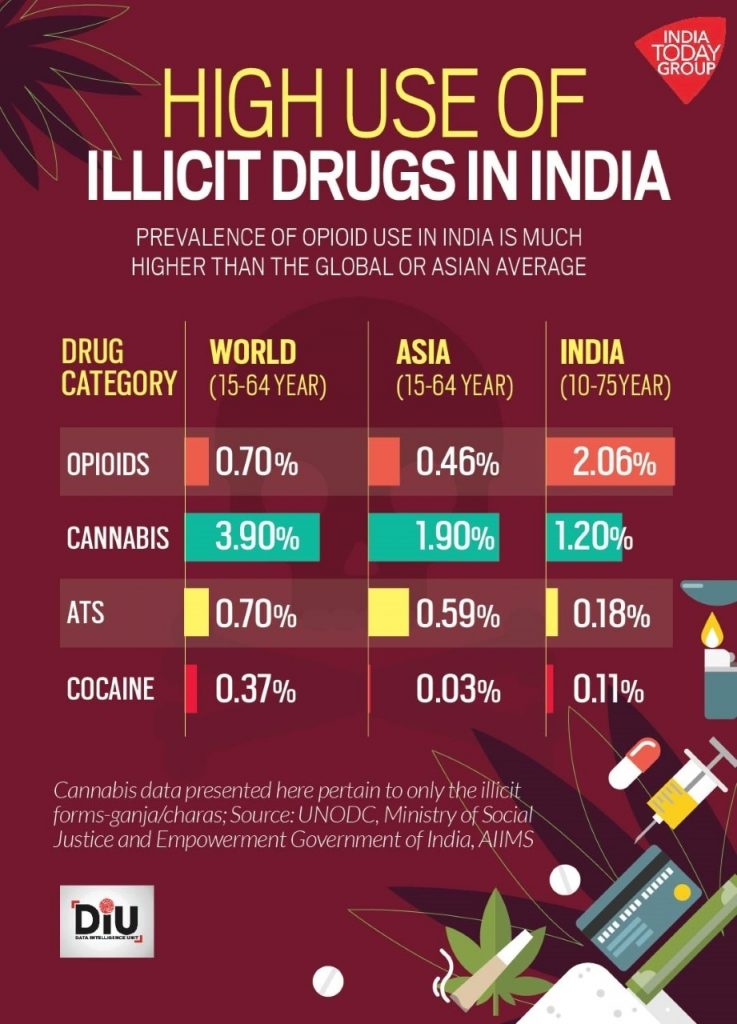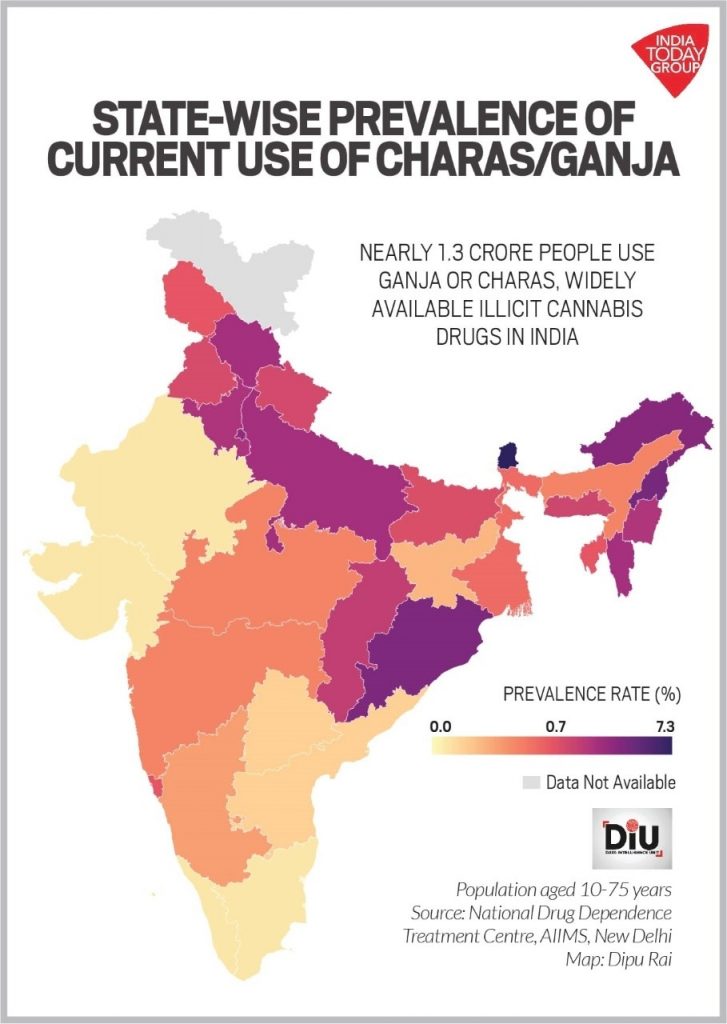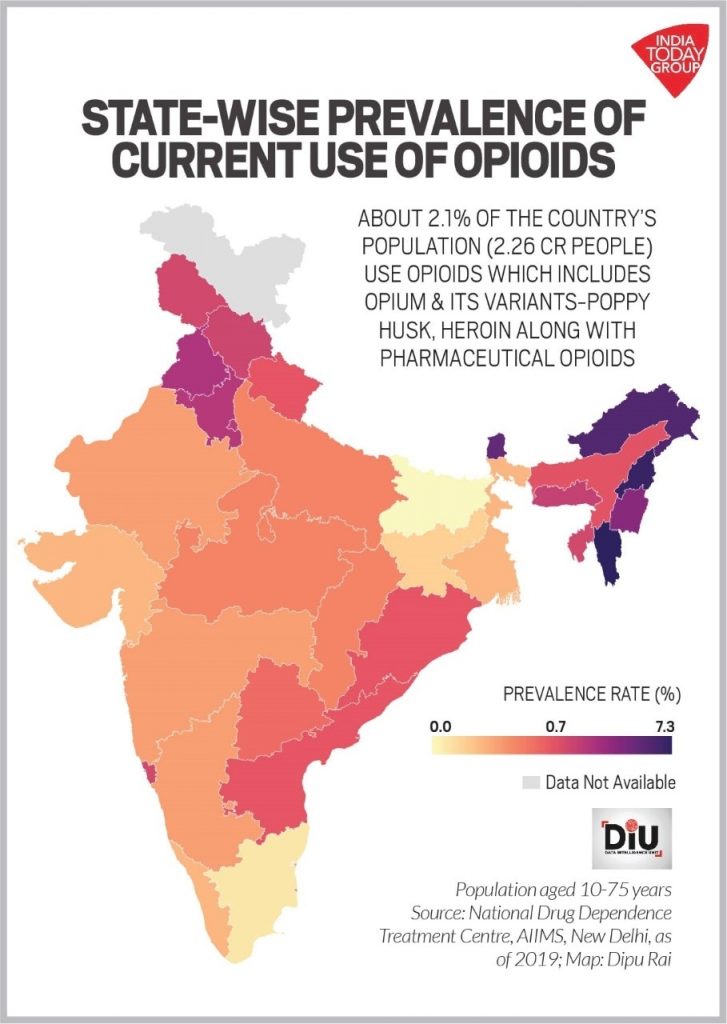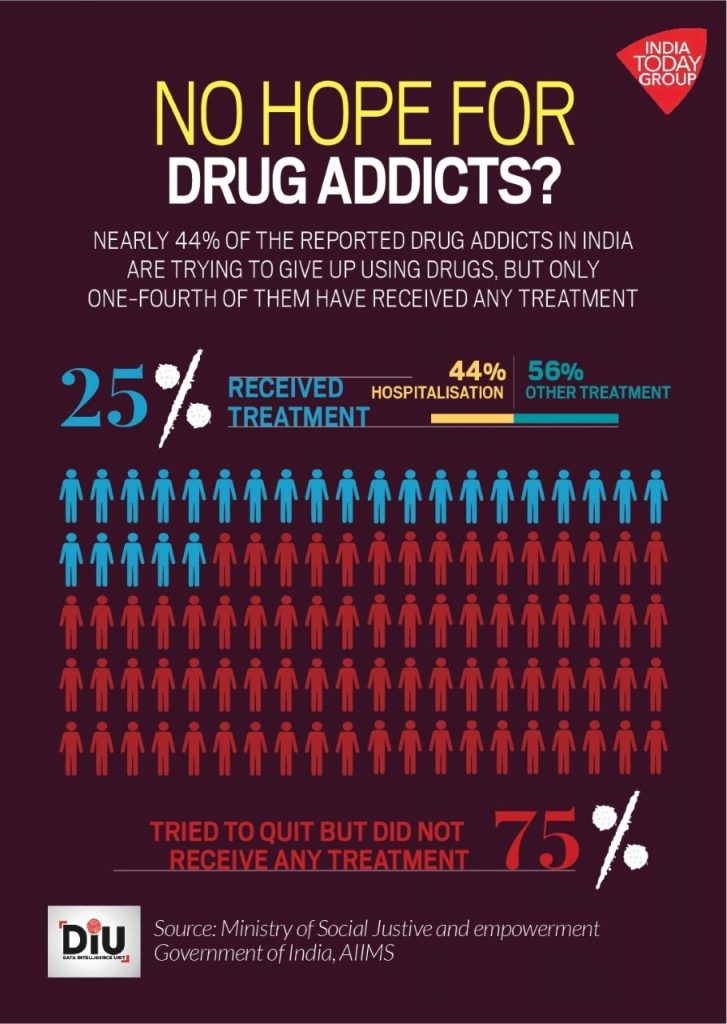Context:
According to a Ministry of Home Affairs (MHA) reply in the Lok Sabha – India has signed 26 bilateral pacts, 15 memoranda of understanding and two agreements on security cooperation with different countries for combating the drug trafficking problem.
Relevance:
GS-III: Internal Security Challenges (Organized Crime and Terrorism), GS-II: International Relations (Important International Agreements and Treaties affecting India’s Interests), GS-I: Indian Society, GS-II: Social Justice (Health related issues, Government Policies and Interventions)
Dimensions of the Article:
- Data on Drug Abuse problem in India: Report by AIIMS
- India’s Vulnerability
- Data Regarding Drug Abuse in the world
- Drug Abuse problem worsening due to Covid-19 Pandemic
- India’s International Coordination to fight Drug Abuse
- Narcotic Drugs and Psychotropic Substances Act, (NDPS)
- India’s Anti-Drug Action Plan for 2020-21
- Other Steps Taken in India
Data on Drug Abuse problem in India: Report by AIIMS
- In terms of users, India’s illicit drug markets are mostly dominated by cannabis and opioids. Alcohol is the most abused substance in India.
- The use of illegal cannabis in India is much lower than the global average – less than one-third. However, opioid use is three times higher than the worldwide average.
- Cannabis in the form of bhang is legal in India, whereas its other forms – ganja (marijuana) and charas (hashish) – are illegal. Opioids are sold as opium (doda, phukki or poppy husk), heroin (brown sugar, smack) and pharma opioids.
- India reported more than 2 crore opioid users in 2018, which was a five-fold jump in 14 years.
- The maximum growth was reported in consumption of heroin.
- India has more than 1 crore sedative users, the maximum number being in Uttar Pradesh, followed by Maharashtra, Punjab and Andhra Pradesh.
- Some drug users, relatively less in number, are taking the inhalational route and psychoactive drugs.
- Inhalants are the only drug category prevalent among children. More than 1% of children consume inhalants. Nearly 18 lakh adults and 4.6 lakh children are in the badly-addicted category.
- Cocaine is the less popular illicit drug in India with more than 10 lakh users. Being pretty expensive, it is mostly used by the well-off.
- Another drug category, hallucinogens, is used in limited circles, with over 12 lakh users in this category, of which one-third are in the harmful or dependent category.
- Findings show there are an estimated 8.5 lakh people who inject drugs (PWID) in India. Almost half of them inject heroin, while the same proportion is using injectable pharmaceutical opioids.




India’s Vulnerability
Golden crescent
- The Golden Crescent is the name given to one of Asia’s two principal areas of illicit Opium production, located at the crossroads of central, south and western Asia.
- This space overlaps three nations, Afghanistan, Iran and Pakistan whose mountainous peripheries define the crescent.
Golden triangle
- The Golden Triangle is located in the area where the borders of Thailand, Myanmar and Laos meet at the confluence of the Ruak and Mekong Rivers.
- Along with the Golden Crescent, it is regarded as one of the largest producers of opium in the world since the 1950s until it was overtaken by the Golden Crescent in the early 21st century.

Data Regarding Drug Abuse in the world
- One out of three drug users is a woman but women represent only one out of five people in treatment.
- People in prison settings, minorities, immigrants and displaced people also face barriers to treatment due to discrimination and stigma.
- Number of people using drugs in 2018 increased by 30% from 2009, with adolescents and young adults accounting for the largest share of users.
- While the increase reflects population growth and other factors, the data nevertheless indicate that illicit drugs are more diverse, more potent and more available.
- At the same time, more than 80% of the world’s population, mostly living in low- and middle-income countries, are deprived of access to controlled drugs for pain relief and other essential medical uses.

Drug Abuse problem worsening due to Covid-19 Pandemic
- The economic downturn caused by the global pandemic may drive more people to substance abuse or leave them vulnerable to involvement in drug trafficking and related crime.
- In the global recession that followed the 2008 financial crisis, drug users sought out cheaper synthetic substances and patterns of use shifted towards injecting drugs, while governments reduced budgets to deal with drug-related problems.
- All over the world, the risks and consequences of drug use are worsened by poverty, limited opportunities for education and jobs, stigma and social exclusion, which in turn helps to deepen inequalities, moving us further away from achieving the Sustainable Development Goals (SDGs).
India’s International Coordination to fight Drug Abuse
- The Narcotics Control Bureau (NCB) coordinated with various international organisations for sharing information and intelligence to combat transnational drug trafficking.
- The Various International Organizations that the NCB works with include:
- The SAARC Drug Offences Monitoring Desk; Brazil, Russia, India, China and South Africa (BRICS);
- Colombo Plan: A regional organisation of 27 countries designed to strengthen economic and social development of member countries in the Asia-Pacific region;
- Association of Southeast Asian Nations (ASEAN) and ASEAN Senior Officials on Drug Matters (ASOD);
- Bay of Bengal Initiative For Multi-Sectoral Technical and Economic Co-Operation (BIMSTEC);
- The United Nations Office on Drugs and Crime (UNODC);
- The International Narcotics Control Board (INCB).
- For coordination among various Central and State agencies, the Narco Coordination Centre (NCORD) mechanism was set up by the MHA in year 2016 for effective drug law enforcement. This NCORD system has been restructured into a four-tier scheme up to district level on July 29, 2019, for better coordination.
Narcotic Drugs and Psychotropic Substances Act, (NDPS)
- The Narcotic Drugs and Psychotropic Substances Act, 1985, commonly referred to as the NDPS Act prohibits a person the production/manufacturing/cultivation, possession, sale, purchasing, transport, storage, and/or consumption of any narcotic drug or psychotropic substance.
- India had no legislation regarding narcotics until 1985.
- The Act is designed to fulfill India’s treaty obligations under the Single Convention on Narcotic Drugs, Convention on Psychotropic Substances, and United Nations Convention Against Illicit Traffic in Narcotic Drugs and Psychotropic Substances.
- The Narcotics Control Bureau is a statutory body that was set up under the act with effect from 1986.
India’s Anti-Drug Action Plan for 2020-21
- The annual Anti-Drug Action Plan for 2020-21 for 272 districts was launched by the Ministry of Social Justice and Empowerment in June 2020.
- The action plan for 2020-21 included awareness generation programmes, identification of drug-dependent population, focus on treatment facilities and capacity-building for service-providers to curb drug abuse and alcoholism.
- De-addiction Facilities would be set up in the “most affected” 272 districts identified by the Narcotics Control Bureau focussing on building up treatment and de-addiction facilities and giving emphasis on reaching the youth and high-risk population.
- Integrated Rehabilitation Centre for Addicts (IRCAs) funded by the Ministry would reach out to communities to help those affected by drug addiction.
Other Steps Taken in India
- Narco-Coordination Centre (NCORD): Government had constituted Narco Coordination Centre (NCORD), the mechanism under Director General (DG), Narcotics Control Bureau (NCB), in order to have effective coordination among all the drug law enforcement agencies and other stakeholders, and also to provide a common platform for discussions on drug-trafficking related issues.
- National Fund for Control of Drug Abuse: The government has constituted a fund called “National Fund for Control of Drug Abuse” to meet the expenditure incurred in connection with combating illicit traffic in Narcotic Drugs; rehabilitating addicts, and educating the public against drug abuse, etc.
- Seizure Information Management System (SIMS): SIMS is a step taken towards digitization of pan-India drug seizure data in 2019 for all the drug law enforcement agencies under the mandate of Narcotics Drugs and Psychotropic Substances Act (NDPS). Narcotics Control Bureau (NCB) was provided with the funds for developing SIMS which will create a complete online database of drug offences and offenders.
-Source: The Hindu



